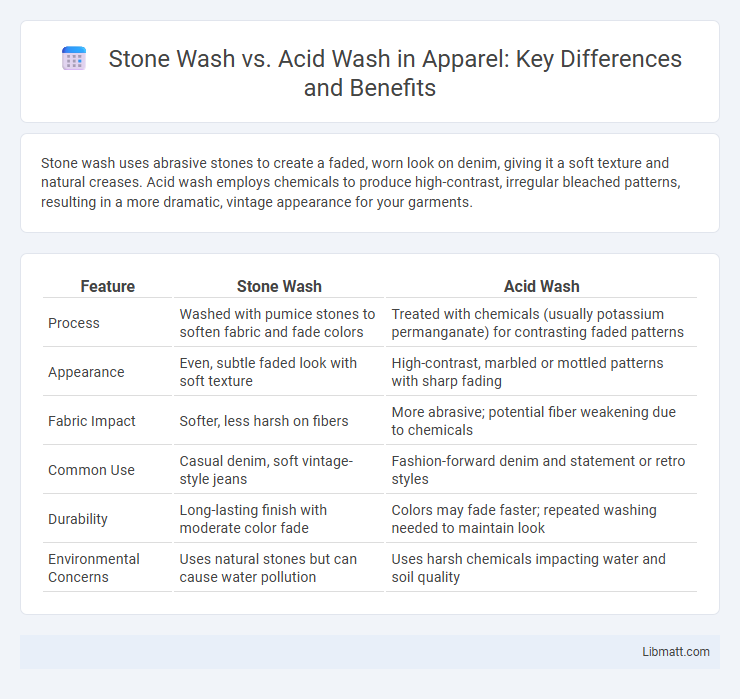Stone wash uses abrasive stones to create a faded, worn look on denim, giving it a soft texture and natural creases. Acid wash employs chemicals to produce high-contrast, irregular bleached patterns, resulting in a more dramatic, vintage appearance for your garments.
Table of Comparison
| Feature | Stone Wash | Acid Wash |
|---|---|---|
| Process | Washed with pumice stones to soften fabric and fade colors | Treated with chemicals (usually potassium permanganate) for contrasting faded patterns |
| Appearance | Even, subtle faded look with soft texture | High-contrast, marbled or mottled patterns with sharp fading |
| Fabric Impact | Softer, less harsh on fibers | More abrasive; potential fiber weakening due to chemicals |
| Common Use | Casual denim, soft vintage-style jeans | Fashion-forward denim and statement or retro styles |
| Durability | Long-lasting finish with moderate color fade | Colors may fade faster; repeated washing needed to maintain look |
| Environmental Concerns | Uses natural stones but can cause water pollution | Uses harsh chemicals impacting water and soil quality |
Introduction to Denim Washing Techniques
Stone wash and acid wash are popular denim washing techniques that create distinct textures and finishes. Stone wash uses pumice stones to physically abrade the fabric, resulting in a softer feel and worn-in look. Acid wash involves chemical bleaching with potassium permanganate, producing high-contrast, marbled patterns that make your denim stand out.
What is Stone Wash?
Stone wash is a fabric treatment process that involves washing garments with pumice stones to create a faded, worn look and a soft texture. This technique enhances the garment's appearance by causing localized fading, making each piece unique while maintaining durability. You can expect stone wash to provide a vintage aesthetic without compromising fabric strength or comfort.
What is Acid Wash?
Acid wash is a fabric treatment process that uses pumice stones soaked in chlorine or potassium permanganate to create a faded, distressed look on denim or other materials. This technique chemically alters the fibers, resulting in a unique pattern of light and dark areas that mimic natural wear and aging. Your choice between stone wash and acid wash depends on whether you prefer a softer, worn-in feel or a more dramatic, high-contrast finish.
Stone Wash Process Explained
The stone wash process involves tumbling garments with pumice stones to create a faded, worn-out look and softer texture by physically abrading the fabric. This method enhances the fabric's durability by removing excess dye and reducing stiffness without compromising the fiber's integrity. Stone washing is commonly used on denim to achieve a vintage appearance and improve comfort.
Acid Wash Process Explained
The acid wash process involves applying a diluted solution of pumice stones and chlorine to denim fabric, creating a faded and textured appearance by partially removing dye. This treatment enhances the garment's vintage aesthetic with unique, irregular patterns, making each piece distinct. Brands use acid wash to achieve a retro, worn-in look while maintaining fabric softness and durability.
Key Differences: Stone Wash vs Acid Wash
Stone wash uses abrasive stones to physically wear down denim, creating a softer texture and a faded, distressed look, while acid wash involves chemicals like potassium permanganate to remove color in blotchy patterns for a high-contrast effect. Stone wash results in a more natural, worn appearance with less dramatic fading, whereas acid wash produces stark, irregular light and dark patches on the fabric. The chemical process in acid wash can weaken fabric fibers more than the mechanical abrasion in stone wash, affecting durability.
Visual and Textural Outcomes
Stone wash produces a faded, vintage look with a soft, worn texture by tumbling jeans or fabric with pumice stones, creating subtle abrasions and color variations. Acid wash achieves a high-contrast, marbled effect through chemical bleaching that lightens fabric unevenly, resulting in a sharper, more dramatic visual pattern with a slightly rougher texture. Both techniques enhance denim's aesthetic appeal but differ significantly in the intensity and style of their visual and tactile results.
Durability and Wear Comparison
Stone wash uses abrasive stones that create a softer, worn-in texture while maintaining fabric strength, making garments more durable for daily wear. Acid wash involves chemicals that break down fibers, resulting in a distinct faded look but reduced fabric integrity and faster wear over time. Your choice depends on balancing the desired aesthetic with the garment's expected longevity and strength.
Environmental and Ethical Considerations
Stone wash uses pumice stones, which can generate significant water pollution and solid waste, raising environmental concerns due to resource consumption and runoff toxins. Acid wash relies on chemicals like potassium permanganate, posing health risks to workers and contributing to hazardous wastewater requiring careful treatment. Ethical practices in both processes demand strict regulation and innovation to minimize ecological impact and ensure worker safety in denim production.
Choosing the Best Wash for Your Denim
Stone wash uses pumice stones to create a softer, worn-in texture with subtle fading, ideal for everyday comfort and vintage aesthetics. Acid wash involves chemicals like potassium permanganate to produce high-contrast, dramatically bleached patterns, perfect for bold, statement denim. Selecting the best wash depends on your style preference, desired garment softness, and the level of distressing you want in your denim.
stone wash vs acid wash Infographic

 libmatt.com
libmatt.com